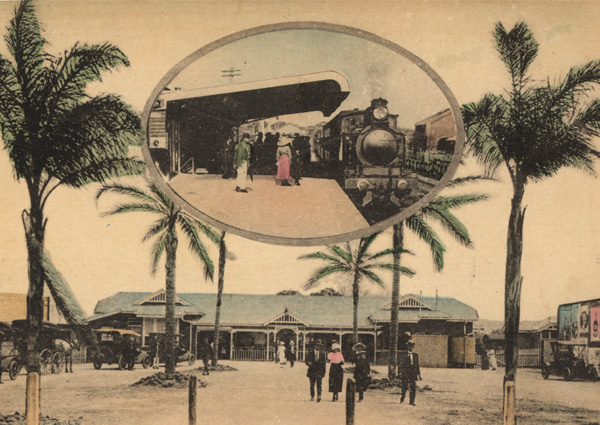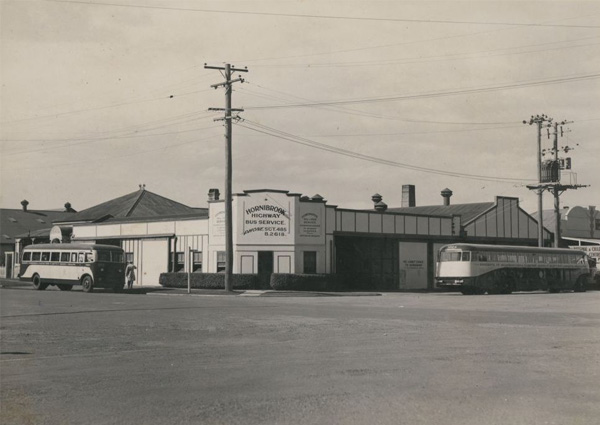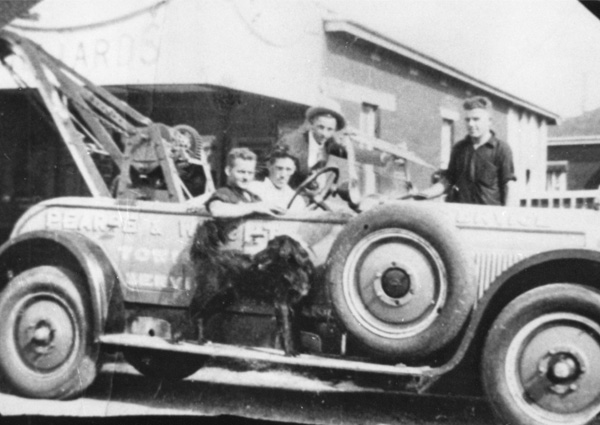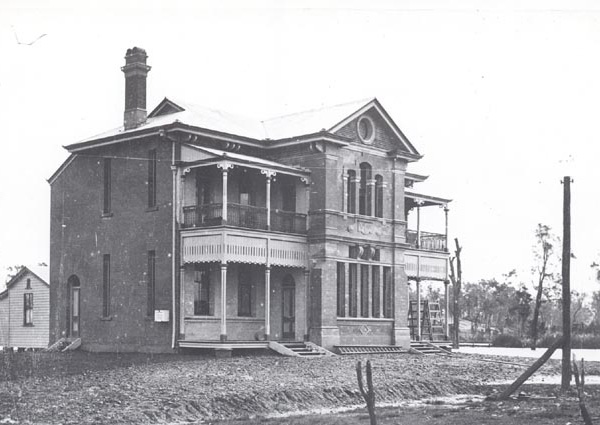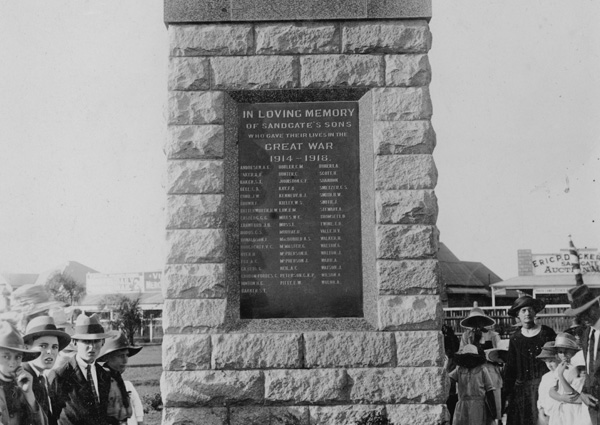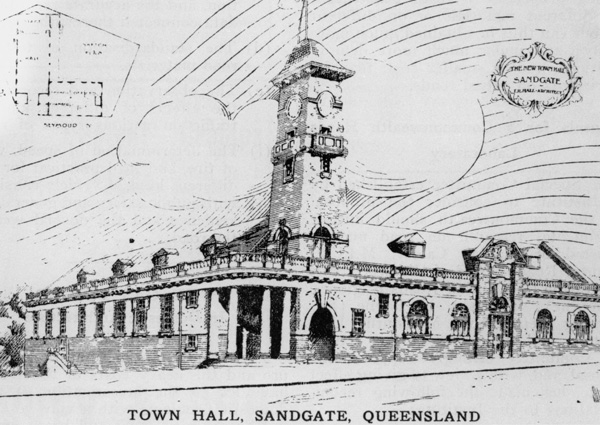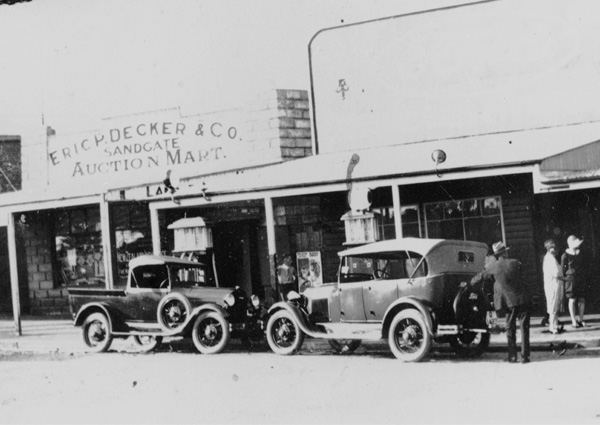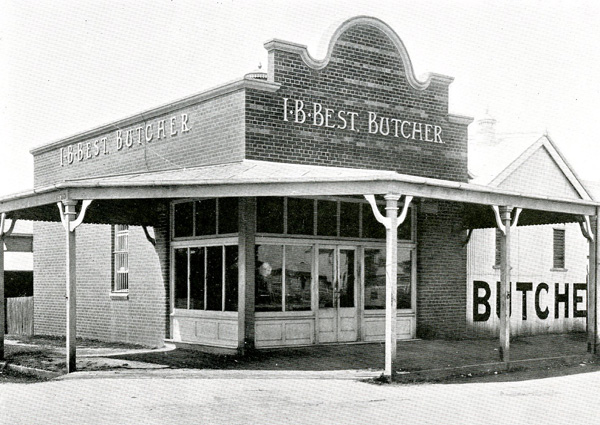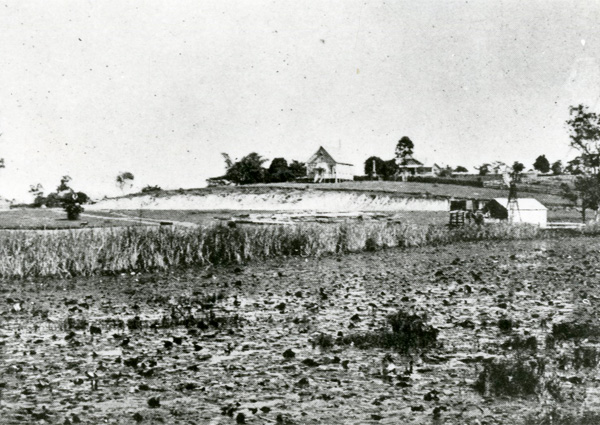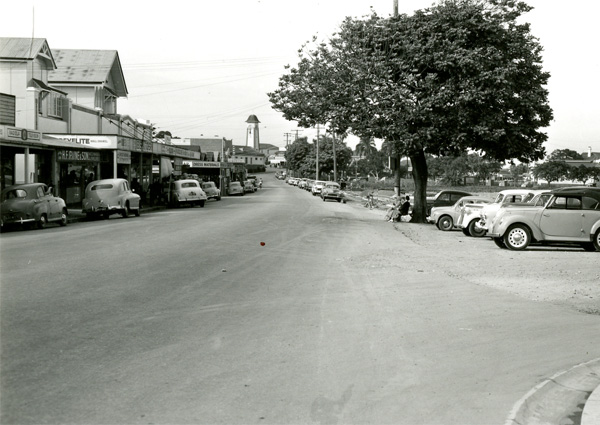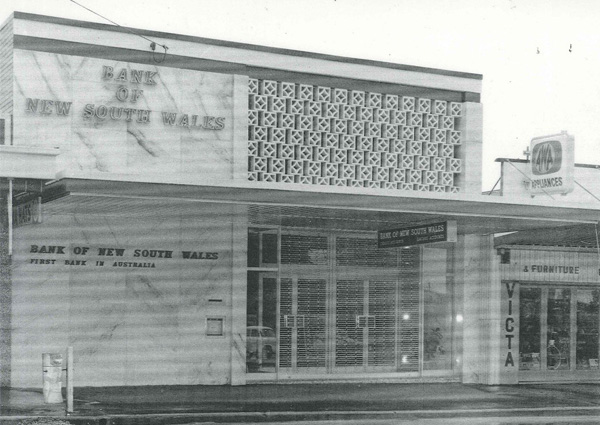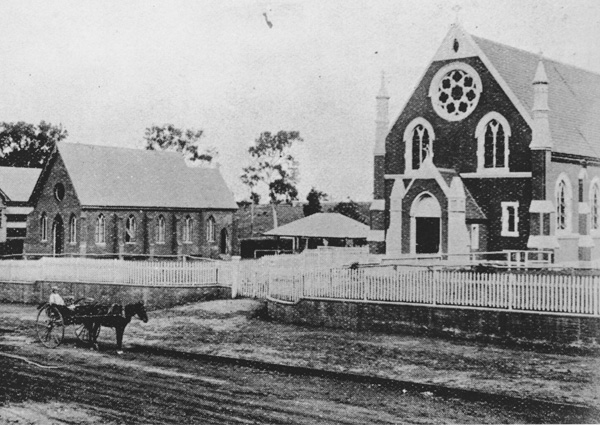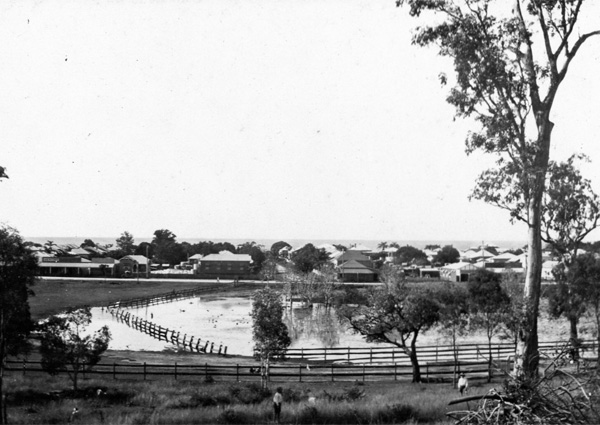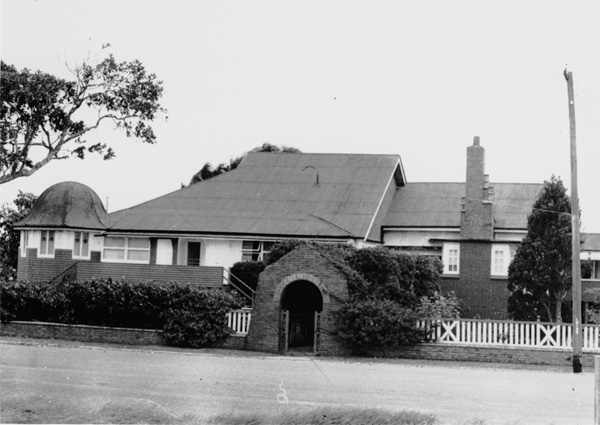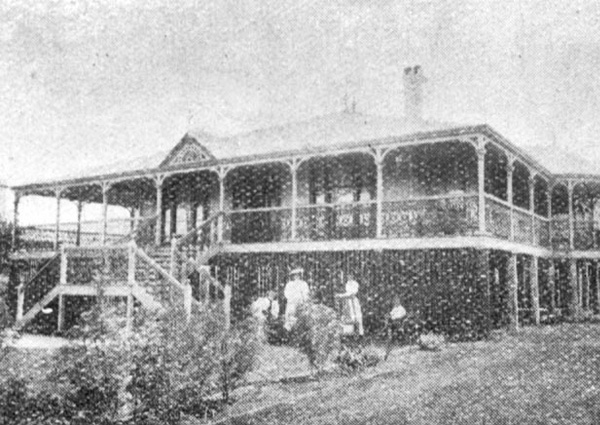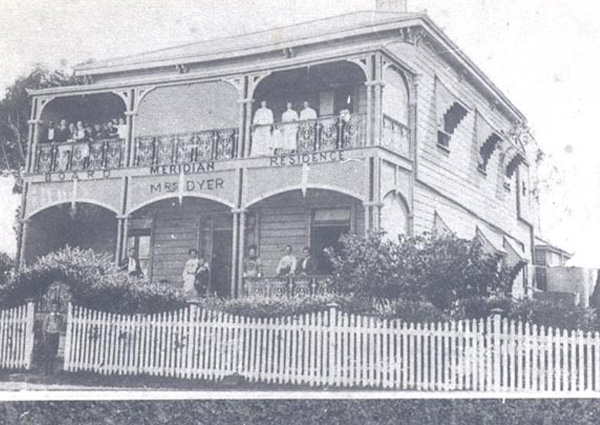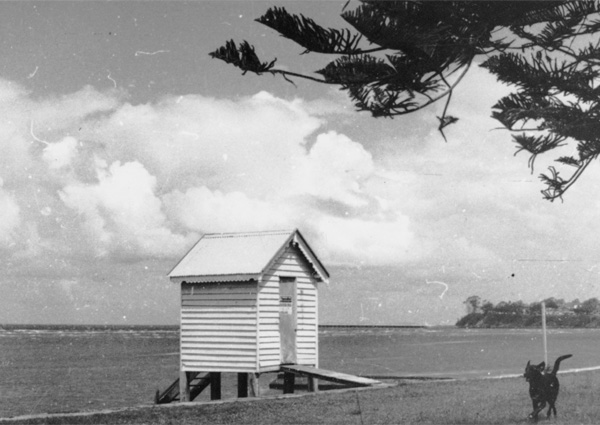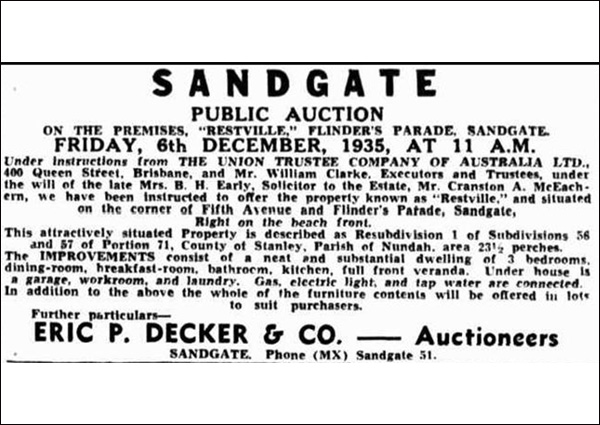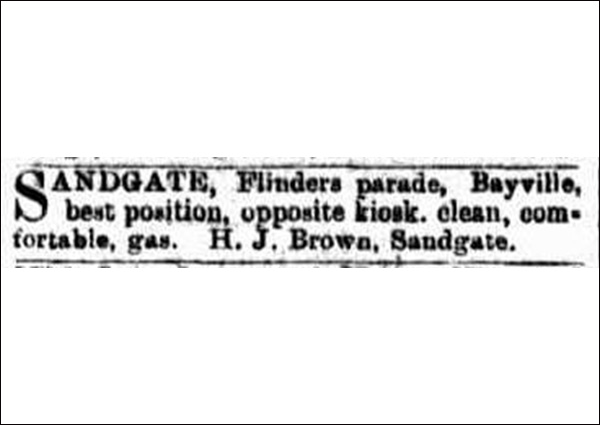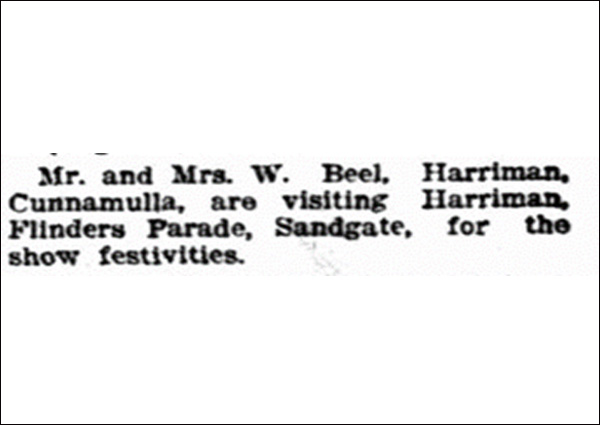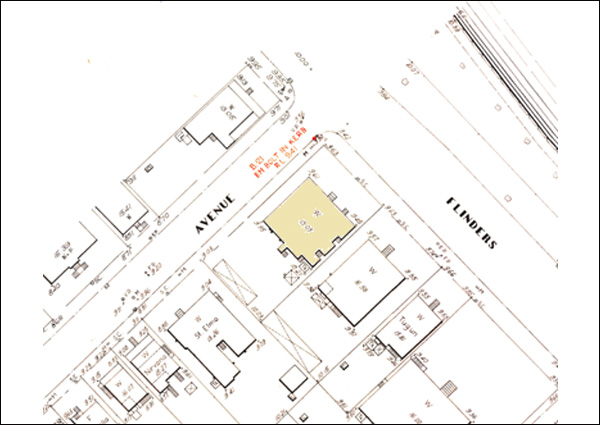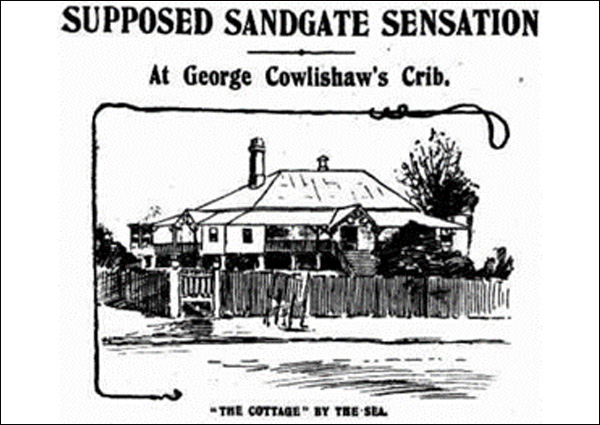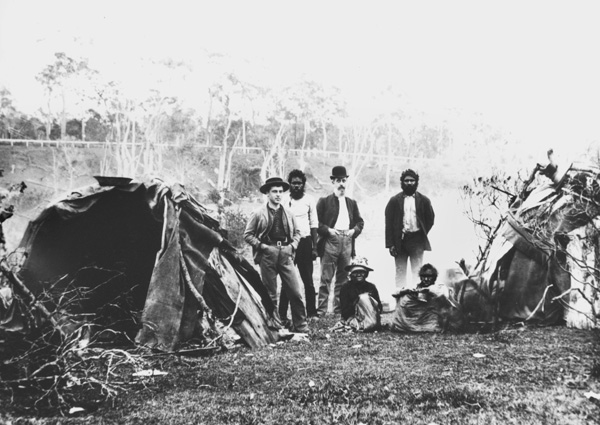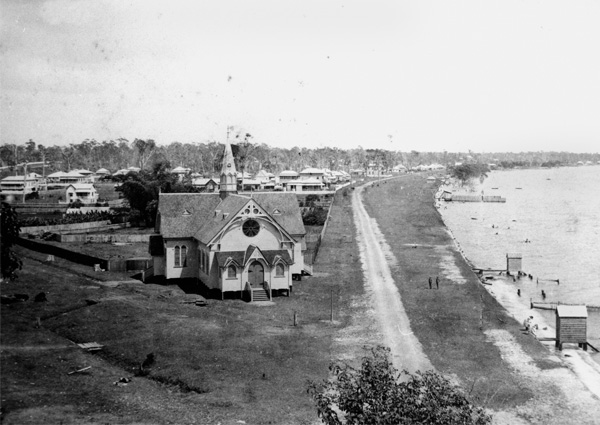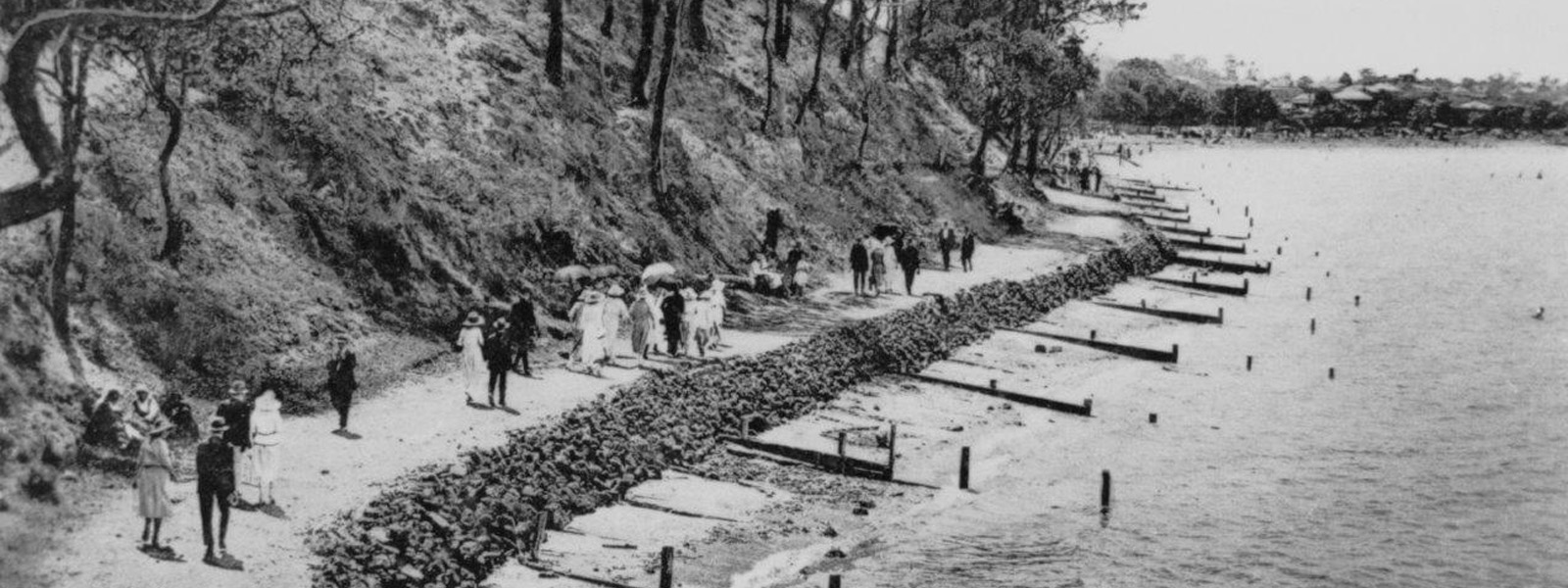
Step through Sandgate Heritage Trail

Step through Sandgate on a journey to places that helped shape the area, including railway landmarks that celebrate its evolution as a sought-after holiday destination, the historic town centre, stately homes, and locations culturally important to local Aboriginal groups.
Follow the Local heritage place trail map below on your mobile device. Or you can download the guide, which includes additional images.
First released in 2018 with 19 places of interest, the 3 km Step through Sandgate Heritage Trail was updated in 2023 and now includes 24 stops.
Optional extension: why not add the neighbouring Shorncliffe Seaside Heritage Trail (4.9 km) to your day trip? Together, these trails tell the history of how Sandgate and Shorncliffe became Brisbane’s premier 19th Century seaside resort towns.
Sandgate Heritage Trail map
Local heritage places
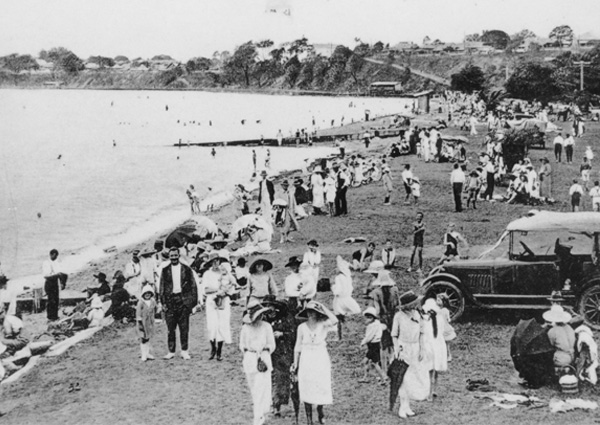
Image credit: State Library of Queensland
Introduction
Prior to European settlement, the Sandgate area was home to a large Aboriginal population with three camps between Einbunpin Lagoon and Dowse Lagoon, including part of what is now the Sandgate Golf Club. The largest camp was located from the southern end of Flinders Parade to the current site of the Baptist Church. It is also thought that there may have been a camp at what is now Moora Park.
The Aboriginal name for the Sandgate area is Warra, meaning ‘expanse of open water’. ‘Sandgate’ was first recorded in 1852 by James Charles Burnett, who used it to describe the area in an official land survey report. The proposed village of Sandgate site was gazetted on 19 March 1853 and Burnett undertook the first sale of town lots at Cabbage Tree Head.
Read more
Read more
In 1824, founding of the Moreton Bay penal settlement heralded the beginning of the European presence in Queensland and the displacement of the Aboriginal people in the area.
The first penal settlement at Moreton Bay was established at Redcliffe but moved in 1825 to the present Central Business District site where there was a better water supply, fewer mosquitoes, and safer anchorage. The convict settlement was closed in 1839 and in 1842 Moreton Bay was officially opened for free settlement as part of the colony of New South Wales.
Prior to European settlement, the Sandgate area was home to a large Aboriginal population with three camps between Einbunpin Lagoon and Dowse Lagoon, including part of what is now the Sandgate Golf Club. The largest camp was located from the southern end of Flinders Parade to the current site of the Baptist Church. It is also thought that there may have been a camp at what is now Moora Park.
The Aboriginal name for the Sandgate area is Warra, meaning ‘expanse of open water’. ‘Sandgate’ was first recorded in 1852 by James Charles Burnett, who used it to describe the area in an official land survey report. The proposed village of Sandgate site was gazetted on 19 March 1853 and Burnett undertook the first sale of town lots at Cabbage Tree Head.
In 1858 a native police encampment was constructed with barracks housing six troopers under the control of Lieutenant Fred Wheeler. From 1864, new settlers continued to arrive in the area, displacing the local Aboriginal people. Among the first Europeans to settle the area were the Slaughter, Davie and Loudin families. Charles Slaughter became the first postmaster for the district.
The construction of a bridge over Cabbage Tree Creek in 1865 marked the beginning of road improvements in the area; however, it was not until 1876 that daily coach services began travelling from Brisbane to Sandgate via Nundah.
By 1880 Sandgate was seceded from Nundah Shire and proclaimed a municipal borough and town with a population of approximately 500 people. Some of the original town councillors were honoured in the names of local streets, including Townsend, Board, Bott, Kift and Deagon.
Long before the Gold Coast and Sunshine Coast gained popularity as holiday destinations Sandgate was Brisbane’s premier seaside resort. When the Sandgate to Brisbane rail line opened in 1882, the area became a popular holiday and daytrip destination, and the population grew to 1500 people over the next decade.
The vice-regal patronage of Lady Bowen, wife to Queensland’s first Governor, Sir George Ferguson Bowen and later Governor George Phipps, Marquess of Normanby, maintained Sandgate as Queensland’s most fashionable seaside resort until the mid-1880s. Reported by newspapers of the day, one of the most successful school excursions to ever take place on the Queensland railway lines occurred in September 1896. A contingent of 900 school children and parents of Ipswich and nearby suburbs travelled to Sandgate on a day trip.
Sandgate was proclaimed a town in 1903 and amalgamated into Brisbane City Council in 1925. While best known as a seaside resort, Sandgate was also home to a strong community spirit and fundraising for various organisations was common. Loved by visitors and residents alike, around 1920 Sandgate even inspired a charming waltz song written by musician Stan Wood and lyricist Tom Shorley.
The opening of the Hornibrook Highway (Hornibrook Bridge) in 1935 detoured many tourists away from Sandgate to Redcliffe. This allowed Sandgate to preserve its early seaside resort charm and retain many of the colonial buildings that characterise its streets today.
1. Sandgate Railway Station - 101 Rainbow Street, Sandgate
This modest low set timber building represents the single greatest influence in the development of Sandgate as a town – the extension of the railway.
Read more
Read more
European settlement of the area started in the 1850s, but it was the extension of the railway line from Brisbane to Sandgate in 1882 that transformed it from an outpost into a very popular holiday and daytrip destination. From 1860-82, the area was serviced regularly by three coach companies that operated between Sandgate and Brisbane, but the journey remained long and arduous. Authorities recognised the potential for better transport and in 1881 a contract was awarded to Henry Pear for construction of Brisbane’s first purpose-built suburban rail service.
Governor Sir Arthur Kennedy officially opened the new station on 11 May 1882, followed by a lunch for nearly 400 people in a large marquee erected near Picnic Point. The Sandgate line was extended to Shorncliffe in 1897. Originally located near Curlew Street, the Sandgate station was moved to its current location in 1909. Sandgate was then renamed Sandgate Central Station and Shorncliffe became Sandgate Station until 1938 when the modern names were adopted.
The railway line to Sandgate was the first suburban line built solely for passengers in the Brisbane area. Providing a quick and efficient train service for the growing number of residents commuting to Brisbane, the railway line enabled travellers to comfortably travel between Brisbane and Sandgate within a day. From 1882 until the 1940s thousands of people travelled regularly to the seaside resort. A record of 8000 people who travelled to Sandgate to celebrate New Year’s Day in 1899 was eclipsed in 1938 on Boxing Day with newspapers reporting almost 10,000 people were carried by 22 trains to Sandgate and Shorncliffe.
For more information about this Local heritage place, refer to Local Heritage Places online.
2. Hornibrook Highway Bus Service Office and Depot (former) – 105 Rainbow Street, Sandgate
With the construction of the Hornibrook Bridge, also known as the Hornibrook Highway, in the 1930s, Manuel Richard (M.R.) Hornibrook saw an opportunity to develop a transport link between Sandgate and the Redcliffe area.
Read more
Read more
Mr Hornibrook was a man of incredible drive and initiative. His company, M.R. Hornibrook Ltd, was associated with many construction projects across Queensland and New South Wales but was primarily known for its bridge-building efforts. The Hornibrook Highway, William Jolly Bridge, the new Victoria Bridge and the Story Bridge are well known examples of the company’s work.
The Hornibrook Highway made access to the Redcliffe peninsula a lot faster and easier than the previous ferry crossing and longer alternative land journey. For those dependent on public transport, a bus service to connect Sandgate Railway Station with the Redcliffe peninsula was a logical choice.
After securing the contract to run the service, Hornibrook Highway Ltd incorporated a new company, Hornibrook Highway Bus Service Ltd, and commenced the bus service between Sandgate Railway Station and the Redcliffe area on the 5 October 1935, the day after the Hornibrook Bridge opened.
With the provision of the service, a suitable place for a bus depot and office was needed. The site on the corner of Rainbow Street and Knox Street (previously called John Street) had been formerly occupied by the stationmaster of the Sandgate Railway Station and was in a prime location for the bus depot and associated office.
Sandgate Town Council’s approval for the bus depot required it to be of good appearance, so Mr Hornibrook engaged Brisbane-based architect Clifford Ernest Plant to design the building. Perhaps as a nod to the Art Deco style of the Hornibrook Bridge entry portals, the former Hornibrook Highway Bus Service Office and Depot displays intact Art Deco features such as the stepped silhouette of the parapet facade, distinguished entrance and stylised low-relief ornamentation.
The bus service was well patronised for many years, experiencing its highest use during peak holiday times. The Easter long weekend in 1945 saw a record number of visitors to all beachside holiday destinations, including Sandgate. The Courier-Mail reported that the Hornibrook Highway Bus Service fleet of 26 motor buses was “fully occupied on Thursday, taking passengers from trains arriving at Sandgate to the Redcliffe area".
In the mid-1970s the Hornibrook Highway tolls ceased and Mr Hornibrook sold the Hornibrook Highway Bus Service Ltd. The Hornibrook Highway Bus Service Office and Depot site at Sandgate was sold in 1977, with a new company, Hornibrook Bus Lines Pty Ltd, created and operated from a depot at Klinger Road in Redcliffe.
For more information about this Local heritage place, refer to the Local Heritage Places online.
Note: Please do not enter. This is a privately owned property and is not open to the public.
3. Sandgate Billiard Saloon (former) – 73 Rainbow Street, Sandgate
Built in 1922, the former Sandgate Billiard Saloon at 73 Rainbow Street is a rare surviving example from the interwar period of a purpose-built billiard saloon in outer Brisbane. It is the area’s only remaining billiard saloon from the 1940s, and still provides evidence of its former use.
Read more
Read more
With European origins, billiards was initially played outdoors on a grass surface and is believed to have been around since the 16th Century. At some point the game was brought indoors and converted to table play, while the outdoor version evolved into croquet. It is said that the green cloth of the billiard table reproduced the grass of the original game.
In Australia, billiards was played privately during the early European settlement. It wasn’t until the 1850s, following various gold rushes, that public billiards games became more common. Almost all public billiard tables were housed in hotels; however, from the late 1800s, purpose-built billiard parlours and saloons developed in areas where there was access to good public transport or in major population centres. Billiard saloons grew in popularity as an alternative social activity to going to the pub though, like pubs and hotels, required a licence from the State Licensing Commission.
By the late 1920s, billiard halls across many parts of Australia were becoming notorious for illegal activities. Betting on billiard games had attracted the attention of starting price (SP) bookies, who were soon accommodating punters for horse racing and other sporting fixtures. In 1934, police raided the Sandgate Billiards Saloon, known as Gormley’s Billiard Saloon, where they found punters before the races. Along with the proprietor, Charles John Gormley, several men were charged and fined for being found in a common gaming house.
For more information about this Local heritage place, refer to the Local Heritage Places online.
Note: Please do not enter. This is a privately owned property and is not open to the public.
4. Sandgate Post Office (former) – 94 Rainbow Street, Sandgate
While a temporary post office had operated on Eagle Terrace, Sandgate, since 1864 the coming of the railway in 1882 created an impetus for the construction of more permanent public buildings.
Read more
Read more
The current Sandgate Post Office site on Bowser Parade was purchased in the early 1880s for £800 and its building constructed in 1886-87. The initial design was produced under the supervision of Colonial Architect (1883-85) John James Clark, following a request from the Post and Telegraph Department in June 1885. Proving too costly, the design was abandoned, and fresh plans were later prepared under the supervision of George Connolly, Mr Clark’s replacement and the first Queensland-born appointment to the position of colonial architect.
Due to the amount of post delivered to Sandgate, the public criticised the decision to build a new post office before other public works as unwarranted. The impressive building was also considered uncommonly substantial for what was to later become a suburban office.
Officially opened on 7 May 1887, the new post and telegraph building reflected government confidence in the booming economy and the importance of Sandgate as both a popular seaside resort and growing residential district. The building housed residential accommodation for the postmaster on the first floor. A dining room, post and telegraph offices and public area occupied the ground floor. The post office also had a detached service wing housing the kitchen, servant’s quarters and wash house.
A telephone service was introduced in 1898. An exchange installed in 1907 was moved to a new building c. 1959. The Post Office remained in operation until 2004 when it was sold to a private owner.
For more information about this State heritage place, please refer to the Queensland Heritage Register.
Note: This is a privately owned property.
5. Sandgate War Memorial Park – 8 Seymour Street, Sandgate
Like many small communities, the First World War had a profound effect on Sandgate. Across Australia, the erection of war memorials peaked between 1919-25 as a means for communities to publicly express their grief and begin healing. Often, war memorials were also seen as a matter of local pride, reflective of an area’s patriotism and wealth.
Read more
Read more
The decision to erect a local Sandgate war memorial was first raised in 1918 to celebrate the Armistice – the end of the war. A committee chaired by the Mayor, Alderman W.H. Bowser, was established by the Sandgate Town Council to raise funds through public subscription.
The Sandgate memorial was designed by prominent architect George Gray Prentice, director of firm Hall and Prentice, best known for its later design of Brisbane City Hall. Approximately 100 tons of granite and concrete at a cost of approximately £850 was used as part of the Sandgate War Memorial by masons Lowther and Sons. Alderman Bowser donated the granite blocks from his quarry at Samford. The borders of the trachyte panels were made of polished Victorian granite – chosen for its resistance to sea air.
Unveiled on 24 February 1924 by the Governor, Sir Matthew Nathan, the memorial recorded the names of all local servicemen killed in the conflict. In a speech, Brigadier J.H. Cannan stated that Sandgate had lost 51 of the 330 soldiers enlisted from the local area.
A verse written by committee member Mr W Lister was included on one side of the memorial, and reads:
“They died, and yet in memory shall they live,
That we may know the worth of sacrifice,
Know that their death in freedom’s cause,
Stands, as a beacon light to point the way,
To paths of peace.”
The names of those killed in the Second World War, and Malaya, Korea and Vietnam wars were added in subsequent decades.
In addition to the war memorial, the large, small-leaved fig located in the surrounding triangular park is believed to have been planted by Hezekiah Shepherd, an inspector and overseer of works with the Sandgate Municipal Council in the early 1880s.
A rotunda was built around the memorial to mark the Australia Remembers commemorations in 1995.
For more information about this State heritage place, please refer to the Queensland Heritage Register.
6. Sandgate Town Hall (former) – 5 Brighton Road, Sandgate
Sandgate was initially part of the Nundah electoral district and was known as the Borough of Sandgate. In 1902 it was declared the Town of Sandgate, and the Sandgate Municipal Chambers were constructed in Kate Street, Shorncliffe.
Read more
Read more
Following a fire that destroyed the building in 1910, Council decided to rebuild in a new, more centralised location. The chosen site was close to the Post Office, School of Arts and relocated Sandgate Central Railway Station. Also located near a police building (now removed) and railway station master’s residence, this group of buildings created a dedicated town centre.
Local resident and architect Thomas Ramsay Hall designed the Sandgate Town Hall and Mr J Gemmell won the building contract. Mr Hall had incorporated elements of the new arts and craft movement in his design, making the building one of today’s few remaining civic examples of Australian Federation-style architecture.
Sir William McGregor, Governor of Queensland, laid the foundation stone on 14 October 1911 and 11 months later with a total construction cost of £5000, the building was officially opened by Sir McGregor at a ceremony attended by 500 people. The clock tower remained without a clock until 1923 when Brisbane watchmaker Mr Bright acquired and installed the former Ipswich Town Hall clock. It was built in 1877 by Gillet and Johnstone of Croydon, England, and is reputedly one of the oldest working clock examples in Brisbane.
After Sandgate and other town and shire councils in the Brisbane area amalgamated with the greater Brisbane City Council in 1925, the town hall building continued to be used as a community hall.
For more information about this State heritage place, please refer to the Queensland Heritage Register.
7. Decker Building – 8 Brighton Road, Sandgate
As Sandgate developed into a seaside resort in the 1880s, commercial shops became more common than trade services. The commercial buildings along Brighton Road date from the 1880s-1960s and tell the story of how Sandgate’s business hub developed over time.
Read more
Read more
By 1920, the Decker Building at 8 Brighton Road, Sandgate, was built for local businessman and, later, politician, Eric Paul Decker. Returning from the First World War after serving in France, Eric Decker opened “Eric P Decker & Co Sandgate Auction Mart” on Brighton Road. When he entered politics in 1931, his brother, George Shirley (Shirley), became involved in the real estate business.
Shirley Decker was also a keen advocate for Sandgate, writing prolifically to newspapers and holding positions on various committees, such as being the secretary and treasurer of the Sandgate Publicity Committee, formed in 1935 to advertise and popularise Sandgate.
As an alderman with Brisbane City Council during the Second World War, Eric Decker set an example in petrol economy for his constituents and Council staff. During this wartime period, petrol was restricted to control the supply of Australia’s limited reserve stocks. Alderman Decker used public transport to get to and from Sandgate and City Hall. As Chairman of the Council’s Works Committee, he also issued orders in July 1940 that every Council vehicle was to be branded. He appealed to the public to report to City Hall any vehicle marked B.C.C. seen outside Greater Brisbane or being used privately in the city.
When he was elected to State Parliament, Eric Decker he voted against an increase in salary for parliamentarians and, although the salary bill passed, he did not accept the increased salary. During this time, Mr Decker MP purchased a new residence at 50 Flinders Parade, Sandgate, known as Torquay (Stop Number 21). He transferred ownership of 8 Brighton Road to his brother Shirley in 1946 and, within a few years, the building had been remodelled to include a second storey and a distinctive stepped parapet. Shirley Decker continued to operate a successful real estate business and his son, John, followed him into the business around 1969 until the business sold in 1999.
Decker Park, at 18 Twenty-Fifth Avenue, Brighton, is named after Eric Decker MP, acknowledging his interest in public affairs and civic matters in the local area, including time as a local alderman and Member of State Parliament.
The Decker Building is named after the Decker family that had a longstanding association with it, and played a prominent role in the local area for well over 100 years. Father of Eric and Shirley, Edward H Decker, was a well-known auctioneer and estate agent in Shorncliffe and later Redcliffe in the early parts of the 20th Century. He had also served as president of the Sandgate School of Arts, Sandgate Progress Association, and as a member of numerous school committees.
For more information about this Local heritage place, refer to Local Heritage Places online.
Note: Please do not enter. This is a privately owned property and is not open to the public.
8. I. B. Best Butcher Shop (former) - 37 Brighton Road, Sandgate
Another building that tells the story of the development of Sandgate’s business hub is the former I.B. Best Butcher Shop. The Federation-style shop is one of the few earliest remaining shops along Brighton Road, Sandgate’s main commercial street, developed in the early 20th Century.
Read more
Read more
Designed in 1912 by noted Brisbane-based architect Edward M. Myers and built by 1913, the former I.B. Best Butchers Shop located on a prominent corner lol is a rare example of a single storey, Federation-style brick commercial building with a curved decorative parapet.
Constructed for noted local businessperson Isaac Benjamin (I.B.) Best, the building’s architectural design, location and the materials used, reflect his success as a butcher. Mr Best was also philanthropic, donating soup meat to the Sandgate Soup Kitchen that operated from the Sandgate School of Arts building in 1919 during the influenza outbreak.
That same year, he and another Sandgate butcher, R.J. Jackman, were both fined by the City Summons Court following a complaint that they failed to keep the front door of their shops closed, as required by the slaughtering regulation of the time.
The irony in his business name was not lost on someone writing to The Australian Woman’s Mirror in 1928, who commented on apt names of tradesmen, stating “a butcher in Sandgate (Q.) has painted in large lettering on the side of his shop 'I.B. Best, Butcher', yet they say self-praise is no recommendation”.
When Mr Best passed away in 1925, his obituary described that he was as “an old and highly respected resident of Sandgate and had taken a prominent part in all the public activities of the town. He was a member of the local Masonic Lodge, the Bowling Club and the Brisbane and Sandgate Gun Clubs”.
For more information about this Local heritage place, refer to Local Heritage Places online.
Note: This is a privately owned property.
9. Einbunpin Lagoon – Brighton Road, Sandgate
The area now occupied by the bayside suburb of Sandgate once offered abundant food and resources to local Aboriginal people from the local lagoons, mangroves and bushlands.
Read more
Read more
Einbunpin Lagoon takes its name from a reed (typha), which was valuable for its fibres and edible roots. Einbunpin is one of three lagoons in Sandgate alongside the largest, Dowse Lagoon, named after early settler Thomas Dowse, and Third (Bungwall) Lagoon, named for its supplies of bungwall, an edible swamp fern root. Local plants such as tea tree, cotton tree, pandanus and reeds provided material for rope, baskets, containers and ornaments for the local Aboriginal people.
Originally a free formed teardrop-shaped lake, Einbunpin Lagoon is now kidney shaped and approximately one quarter of its original size. Aboriginal camps dotted the open woodlands surrounding the lagoons, swamps and waterholes and along the foreshores until European settlers started taking up land in the 1850s.
The lagoons were valued for their scenic contribution to the townscape. A haven for wildlife, they also became a popular spot for hunting, fishing and duck shooting. A windmill and pumps erected in the 1920s to provide water to the town from Einbunpin and Dowse lagoons were dismantled in the 1940s.
By 1931 the Town Planning Association identified the site as a landmark worthy of preservation, and in 1934 Ned Hanlon, Member of the Legislative Assembly and later Premier of Queensland, arranged for the area to be declared a bird sanctuary, park and recreation reserve. Located in the centre of modern Sandgate, Einbunpin Lagoon continues to form a natural backdrop for the civic, community and retail activities in the area.
For more information about this Local heritage place, refer to Local Heritage Places online.
10. Nugent’s Buildings – 85 Brighton Road, Sandgate
Nugent’s Buildings, constructed in 1929 to a design by the noted architectural practice of Cavanagh and Cavanagh, demonstrate the strengthening of commercial development along Brighton Road as the main shopping street in Sandgate.
Read more
Read more
Commissioned by then owner Mr William James Nugent, the buildings are an elegant, well-designed example of a block of shops with associated upper-level dwellings. Designed between the First and Second World Wars, the buildings address the long street edge as well as the corner location. The upper level incorporates domestic details reflecting its original residential use. The decorative parapet with stylistic detailing and pediment reliefs set up a rhythm of bays that delineate the multiple tenancies.
In 1940, Mr Nugent engaged the same architects for an addition along Brighton Rd, which included three shops and a dwelling and involved raising of a cottage already present on the lot. Its extension and continued use demonstrate the success of Nugent's Buildings as part of the Brighton Road shopping street. Both the 1929 building and 1940 addition make a positive contribution to the streetscape.
A licensed House, Land and Commission agent, Mr Nugent was a well-known and social member of the community, participating in a number of fundraising and other community events. He was a member of the Sandgate Jockey Club and in 1931 he was also elected an officer of the Sandgate Progress Association, representing the Central area.
Mr Nugent passed away in 1950. The well-attended funeral was held a little further along Brighton Road at the Sacred Heart Church, where he had also wed Miss Ellen Carroll in 1926. The Sacred Heart Church is Stop Number 12 on this trail.
For more information about this Local heritage place, refer to Local Heritage Places online.
Note: This is a privately owned property.
11. Bank of New South Wales (former) - 101 Brighton Road, Sandgate
Designed by noted Brisbane-based architects Theo Thynne and Associates and constructed in 1961, the former Bank of New South Wales is a three storey, split-level building reflective of mid-century Modernist purpose-built bank architecture. The building is significant in demonstrating the evolution of commercial building development along Brighton Road, Sandgate’s main commercial street, as well as demonstrating changes that occurred in the design of bank buildings in Australia after the Second World War.
Read more
Read more
Before the Second World War, banks were designed to convey a sense of confidence in both the services and practices of the bank. A sense of scale, solidity and permanency were underpinning ideas up until this time, illustrated in the use of design features such as grandiose building scale, classical columns, opulent interiors and elaborate security features such as bank vaults.
After the Second World War, approaches moved towards expressing a sense of ‘openness and transparency’ in the design of bank buildings. This was partly driven by economic changes in Australia in the 1950s and 1960s that led to a growth in personal wealth and disposable income. The increasing practice of many banks opening a savings bank subsidiary necessitated the establishment of new bank branches to provide greater customer access to services. Bank branches, including those in the suburbs, also began to incorporate the new Modernist design elements.
The former Bank of New South Wales is an intact example of this mid-century Modernist bank architecture, while continuing to express attributes of strength and stability. The design utilises the simplicity of built form, minimalist detailing, and use of materials. Notable design details include horizontal banding along the top of the facade, a formal window composition, a decorative breeze block screen, Carrara marble cladding, and a grey marble terrazzo threshold to the building entry.
For more information about this Local heritage place, refer to Local Heritage Places online.
Note: This is a privately owned property.
12. Sacred Heart Catholic Church Precinct – 92 Brighton Road, Sandgate
The first Catholic Mass in Sandgate was celebrated in 1865 by Father Patrick Dunne at a private home on Eagle Terrace, with visiting priests then continuing to serve the population during the 1870s.
Read more
Read more
In 1880 following the appointment of resident Catholic priest Reverend J.P.M Connolly, prominent local architect Andrea Stombuco designed the first Catholic Church at 92 Brighton Road, and it was constructed and opened in 1881. From the outset it was anticipated that when the congregation outgrew the original church, it would be used as a school and a second larger church would be constructed.
With the extension of the railway to Sandgate in 1882 and the increasing local population, a larger church was soon proposed, designed and built by local residents William Caldwell and William Street in Federation Gothic-style. Opened in 1892, construction was substantially funded by Father Connolly.
In 1894 a convent (since demolished) was built for the Sisters of Mercy who ran a school from the old church. The sisters had previously travelled by buggy from Nudgee to teach Catechism on Sundays, but Archbishop Robert Dunne, the first Catholic archbishop of Brisbane (1887-1917) would not allow them to travel each day to deliver lessons, and a more permanent accommodation was constructed.
By 1919 the school had outgrown the old church and a new, large and impressive two storey brick facility was built between the two existing buildings. The new school opened in 1920 and, from this time onwards, the old church has been used as a church hall.
In 1935 the newer church was again extended to include a permanent vestry and sanctuary to accommodate the growing congregation.
For more information about this Local heritage place, refer to Local Heritage Places online.
Note: This is a privately owned property.
13. Dowse Lagoon – Sandgate Second Lagoon Reserve, off Brighton Road, Sandgate
The Aboriginal camps located between Dowse, Einbunpin and Third lagoons, and the camp at what is now Flinders Parade, were the location of some of the earliest contact points with Europeans exploring Moreton Bay.
Read more
Read more
A native police depot was established between the lagoon camps. Lieutenant Fred Wheeler oversaw a barracks of six troopers, and police horses were kept in paddocks between Seventh and Eighth avenues.
Camps near the lagoons were still populated by Aboriginal people during the presence of the police depot from 1859-65, but the closure of the barracks in 1865 saw a revival of traditional camps. There is a report from c. 1865-70 that a corroboree of 300 participants was held with hundreds canoeing from Bribie Island to attend a burial. Between 1875 and 1885, numbers in the camps had declined to approximately 50 regular inhabitants.
The population decreased to between five and 12 occupants from 1890-96. However, connections continued further along the coast at Moora Park with people from Deebing Creek and Durundur Reserve attending picnics and sporting competitions between 1898-1918.
Prior to the provision of reticulated water to Sandgate in the 1920s, water was sourced from the lagoons, including Dowse Lagoon. A hand pump was installed on its south edge to pump water to the water carts. With the encroaching urban settlement, Dowse Lagoon has been plagued with water quality concerns and weed infestations.
For more information about this Local heritage place, refer to Local Heritage Places online.
14. Cremorne – 154 Flinders Parade, Sandgate
Cremorne is an unusual addition to the Sandgate architectural landscape, thought to be an amalgamation of two houses dating from c. 1900 and 1913 for John McCallum in 1922.
Read more
Read more
The original houses were cottages. One was owned by Thomas Roderick Gray, co-owner of a boot shop in George Street, Brisbane. The other cottage was first owned by Alexander Stirling, a buying agent who named the house Tangaluma, and then by Marie and William Overell, of Overell’s drapery business in Fortitude Valley, who renamed the cottage Elanora.
Elanora was bought by Mr McCallum in 1920, followed by his purchase of the neighbouring cottage in 1921. He engaged architect Lange L. Powell to undertake extensive alterations. Mr McCallum named the resulting house Cremorne after his theatre in Stanley Street, South Brisbane. At the house, Mr McCallum and his wife entertained frequently and were host to famous theatrical figures and other prominent people. Their son, John Neil McCallum Jr. was a well-known Australian actor and producer, and was an executive producer of the well-loved Australian TV series, Skippy.
John McCallum Sr became involved in Sandgate’s social and civic affairs and served as the inaugural president of the Sandgate Progress Association. A keen golfer, he was a foundation committee member and one of the first vice presidents of the Sandgate Golf Club.
In 1925, the house transferred to the Carrick family, who hosted garden parties and fetes at the property. Cremorne became the centre for social and fundraising events in Sandgate during the 1920-30s. While living at the property, Mr Carrick was engaged to construct the Brisbane City Hall superstructure.
Cremorne was converted into flats in 1937.
For more information about this Local heritage place, refer to Local Heritage Places online.
Note: Please do not enter. This is a privately owned property and is not open to the public.
15. Broadhurst, former Sandgate Home-Maternal and Child Welfare Service - 138 Flinders Parade, Sandgate
Originally named Broadhurst, this residence was built in c. 1900-01 for Hugh and Florence McCall Hicks. Mr Hicks was the general manager of Perkins and Company which, after 1928, became Castlemaine-Perkins, makers of XXXX beer.
Read more
Read more
In 1899, an article in the Brisbane Courier reported the “apathy shown by Sandgate ratepayers” in response to the lack of apparent contestants for the then vacant Alderman’s seats on the Sandgate Town Council. In response, a week later Mr Hicks issued a circular inviting Central Ward ratepayers to vote for him. Though elected, Alderman Hicks’ time on the Sandgate Council was short and he resigned by April 1901, influenced perhaps by the Brisbane Hospital Committee’s interest in his home.
The Brisbane Hospital Committee had rented the property adjacent to Broadhurst from 1885, converting it into a convalescent home after finding that the seaside helped speed the patient recovery, especially those suffering from typhoid fever. Following a visit to his home in 1901, the committee approached Mr Hicks about purchasing his property, which he sold to them for a generous amount of £1250.
Mr D.F. Brown, the house steward (manager), designed alterations to make the building suitable for use as a convalescent home, and patients transferred there from December 1901. The residence operated as a convalescent home until 1942, and nurses worked there as part of their general hospital training for on-the-job experience.
In 1943 the building became the property of the State Health Department’s Maternal and Child Welfare Section and was converted into a residential home for children of seriously ill mothers.
This was part of the government response to the Second World War, when husbands serving away for the war effort left families with only a single caregiver. New buildings including dining and recreation rooms were added to the home in the 1950s, but these were demolished in 1997.
From 1983-94, the property was used by Intellectual Disability Services to provide long-term and short-term residential care for children with intellectual disabilities, and as a family respite centre. This closed in April 1994. The property is now a private residence.
For more information about this State heritage place, refer to the Queensland Heritage Register.
Note: Please do not enter. This is a privately owned property and is not open to the public.
16. Meridian – 130 Flinders Parade, Sandgate
Also known as Meridian Flats, this residence was built in 1885 for prominent publican Peter Murphy as a hotel for visitors arriving on the new Sandgate railway line. Due to the large number of existing public houses and inns, the Sandgate Municipal Council rejected the proposal so the building was completed as a private residence.
Read more
Read more
Mr Murphy leased the property until 1907 when it transferred to Margaret and Edward Dyer. They converted the residence into a boarding house and, in 1919, renamed it Meridian. Mr Dyer had emigrated from England as a young man and worked as a painter. According to his 1938 obituary, one of his first jobs was at Meridian, which he would later call home.
Well known for their interest in lawn bowls, the Dyers established a private three-rink green in their garden. Mr Dyer also helped to found the Sandgate Bowls Club in 1914. Gender restrictions common at the time prevented women from patronising the club, so the Dyers allowed women to play on their private green at Meridian.
In 1938, Sandgate Bowls Clubs members unveiled the Dyer Memorial Gate at the club’s main entrance in memory of Mr Dyer who, whilst club president, had passed away on 25 February that year.
Meridian remained with the Dyer family until 1990 when new owners restored it to a private residence.
For more information about this Local heritage place, refer to Local Heritage Places online.
Note: Please do not enter. This is a privately owned property and is not open to the public.
17. Bramble Bay Foreshore, Sandgate
Bramble Bay within Moreton Bay is believed to take its name from HMS Bramble, a vessel associated with several surveying voyages along the east coast of Australia between 1842 and 1850. Launched in 1822 from Plymouth Dockyard in England, HMS Bramble was a 161-ton, 10-gun cutter that was under the command of Lieutenant Charles Bampfield Yule. It was recommissioned as a tender to HMS Rattlesnake in the original surveying expedition.
Read more
Read more
Once the hub of the Sandgate seaside experience, the foreshore between Fourth Avenue and Fifth Avenue was popular with thousands of holidaymakers and those who were lucky enough to live near the beach.
The Bramble Bay Foreshore consists of more than seven kilometres of parklands at Sandgate, Shorncliffe and Brighton. With the popularity of Sandgate and Shorncliffe as seaside resorts in the late 19th Century, the foreshore provided a recreation place for thousands of holidaymakers that would flock to the area during the holidays.
Lord Mayor William Jolly (1925–1931) was popular for his civic work, making municipal improvements across the city of Brisbane. Such improvements included those along the Sandgate foreshores which, like Wynnum and Manly, were prioritised to also increase their attraction as seaside resorts.
Catering to the every need of holidaymakers, public facilities proliferated along the foreshore and included the Sandgate Pier, Lovers’ Walk, kiosks, jetties, safe bathing facilities and entertainment venues. Surviving features of this era include the Sandgate/Shorncliffe Pier (built 1882), Baxter’s Jetty (1880s; replaced 1923) and the Brisbane Tuff stone sea walls, part of which is a groyne built near the jetty to create a shark-proof enclosure.
The Bramble Bay Regatta, first held in 1883, attracted many contesting boats and, in the early days, steamers crammed with visitors all keen to watch the race. Sailing was not formalised in Bramble Bay until 1912 with the formation of the Sandgate Yacht Club, one of the oldest sailing clubs in Queensland. The Queensland Cruising Yacht Club was formed after the Second World War and was instrumental in initiating the now famous Brisbane to Gladstone Yacht Race in 1949, which traditionally starts on Good Friday.
For more information about this Local heritage place, refer to Local Heritage Places online.
18. Ashwell – 120 Flinders Parade, Sandgate
This large timber residence was constructed around 1894 as an investment property for William Lovell, a Sandgate resident and landowner. Sandgate had become a desirable seaside holiday destination for Brisbane residents following the opening of the railway line in the 1880s, and the house fronting Flinders Parade was a particularly appealing location.
Read more
Read more
It was leased for several years before George and Louisa Colvin purchased the property in 1909, later calling it Ashwell. Mr Colvin was active as a committee member of the Sandgate Progress Committee.
By 1922 the property had been sold to cordial manufacturer Richard Dewdrey Early, who renamed it Hoya and later Restville. Mr Early had emigrated to Brisbane in 1890 from Devonshire, England. Working first as a builder and constructor, he then went into business as an aerated water and cordial manufacture under the name of Eclipse Brewing Company, which operated in South Brisbane. In 1935, the property was again sold after the death of Mr Early and his wife, Bessie, and the home was converted into five self-contained flats.
This Federation-style timber dwelling features prominent verandahs to take advantage of its seafront position. It reflects the residential growth of Sandgate and the appeal of the waterfront at Flinders Parade in the late 19th and early 20th Centuries.
For more information about this Local heritage place, refer to Local Heritage Places online.
Note: Please do not enter. This is a privately owned property and is not open to the public.
19. 104 and 106 Flinders Parade, Sandgate
The two attractively decorated twin residences at 104 and 106 Flinders Parade were built c. 1893 when Sandgate was emerging as a popular holiday destination. The homes were investment properties for Daniel McNab, a tailor and outfitter who owned a successful business in Queen Street. Considered one of Brisbane’s leading drapers at the time, Mr McNab’s Glasgow House, established around 1870, was said to have sold the best and latest lines in drapery, mercery and outfitting.
Read more
Read more
Mr McNab was also carrying on business as a general storekeeper at Landsborough and Yandina when petitions were filed for the liquidation of all his business interests in 1893. He retired not long afterwards.
In 1898, Mr McNab’s entire estate was placed for sale, with the two houses on a quarter-acre holding on the corner of Flinders Parade (then known as Lower Esplanade) and Fourth Avenue (then known as Jane Street) advertised as one of the best beach front properties in Sandgate. It was sold to Hannah Eaton Brown, who retained it until her death in 1944.
Both houses remained on the one lot until the land was subdivided in 2006. They have been occupied by a variety of tenants and may have also been used as short-term holiday accommodation, particularly during the first half of the 20th Century when the beachside town was inundated with holidaymakers in the summer months.
For more information about this Local heritage place, refer to Local Heritage Places online.
Note: Please do not enter. This is a privately owned property and is not open to the public.
20. Harriman – 86 Flinders Parade, Sandgate
The large parcel of land where this residence stands was sold to Emma Matilda Smith, wife of Henry Smith, in 1885. Mr Smith was a building contractor who worked with his brother Alexander Smith, one of the co-founders of the engineering firm Smith and Balls. He appears to have built a house called Cranfordville on the site c. 1886. Mr Smith seemed to have spent at least some time there. In 1889, he was noted as being late of Sandgate when he passed away in New Farm aged 44 years.
Read more
Read more
The house was renamed Harriman by later owners Marion and William Bassett Beel, who also owned a property called Harriman Park at Cunnamulla. The house was used by the Beels for holidays and visits to Brisbane, especially around the time of the Royal National Association Show (now Royal Queensland Show, the Ekka).
Harriman was adjacent to the Beach Theatre and narrowly avoided destruction when the theatre burned down in the 1970s. Converted to flats in the 1950s, it was converted back to a single dwelling at the end of the 20th Century.
For more information about this Local heritage place, refer to Local Heritage Places online.
Note: Please do not enter. This is a privately owned property and is not open to the public.
21. Torquay – 50 Flinders Parade, Sandgate
This fine timber home was built in the late 19th Century when Sandgate was the favoured seaside destination for residents of Brisbane and southern Queensland.
Read more
Read more
The house was built on a 32 perch (approximately 810 square metre) holding that had been transferred into the name of Lewis Drouyn in 1885, following the subdivision of the larger original portion 74. Mr Drouyn was the publican of the Osborne Hotel, now known as the Full Moon Hotel, on the corner of Eagle Terrace and Curlew Street. Emigrating from the Channel Islands in 1866 aboard the Queen of Colonies, Mr Drouyn had a bootmakers establishment in Edward Street, Brisbane. After selling this business, he took over the Fairfield Hotel, running this successfully until he bought the Osborne Hotel at Sandgate in 1880.
Whilst in Sandgate, Mr Drouyn was a member of the Sandgate Turf Club. He also took an active interest in public affairs and was nominated for the office of alderman in 1883. He was an alderman for the Borough of Sandgate for several years until his resignation in 1891.
Mr Drouyn disposed of Torquay in 1894 and by 1897 the property had again changed hands to Miriam Alexander. Following her death in 1918, the property was transferred to her son, John Alexander, and her married daughter, Alice Hannah Baynes. Mr Alexander, a civil servant, had lived with his mother in the house, which they named Avenal. After her death, he later moved to Yeerongpilly.
The siblings sold the house in 1921 to timber merchant and industrialist, James Fairlie Brett. The home was not used as his primary residence for long, with the electoral roll only showing him there in 1922. Mr Brett was the Chairman of Nanango Shire Council from 1922-24. In 1928 as B.C. Brett & Co., Mr Brett with his brother Bertie and others had bought and reclaimed land at Hamilton in Brisbane to build warehouses and a wharf. Brett’s Wharves became a city landmark and handled huge volumes of timber for export.
By 1941, the Sandgate property transferred to local businessman and politician, Eric Paul Decker. Mr Decker was a local alderman representing Sandgate in the Brisbane City Council and, later, a Member of Parliament for the district. Returning from the First World War after serving in France, Mr Decker had opened Eric P Decker & Co Sandgate Auction Mart on Brighton Road. When he entered politics in 1931, his brother George Shirley (Shirley) became involved in the real estate business.
In the post-war period, Sandgate’s popularity as a beachside holiday destination declined and housing shortages prompted the conversion of Mr Decker’s house, like many others, to flats. It was restored to its original grandeur in the 1980s and won the National Trust’s John Herbert Award for excellence in residential conservation work in 1988.
For more information about this Local heritage place, refer to Local Heritage Places online.
Note: Please do not enter. This is a privately owned property and is not open to the public.
22. The Cottage – 40 Flinders Parade, Sandgate
Despite its name, The Cottage had seven bedrooms. This substantial timber residence was built c. 1888 by local builder William Street for William Albert Wilson, a surveyor and the son of Reverend Benjamin Gilmore Wilson, the first Baptist Minister in Sandgate.
Read more
Read more
Mr Wilson was born in Yorkshire around 1856 and had emigrated with his family to Queensland, where his father took charge of the state’s first Baptist Church, then situated at the corner of Wharf and Adelaide streets in Brisbane. One of the first students at Brisbane Grammar School when it opened in 1869, Mr Wilson went on to work with the Union Bank’s Brisbane branch. Abandoning banking for a career as a surveyor, Mr Wilson travelled extensively throughout Queensland. He married widow, Annie Clapperton (nee Kendall) in 1878 at Tarong whilst working in the district, and it was there that they started a family.
While ministering in Sandgate, Mr Wilson’s father had bought a large landholding in the area. After the Reverend’s death in 1878, subdivision of the larger holding known as Wilson’s Paddock or Wilson’s Estate began. The Cottage was constructed on subdivisions 9, 10 and 11, with ownership split amongst Mr Wilson and his children who were minors.
From about 1895, The Cottage became the residence of Sydney-born architect George Cowlishaw, whose hospitality gave the house a reputation as the very temple of good fellowship. Mr Cowlishaw had come to Brisbane in 1862 and, with his brother James Cowlishaw, designed several significant buildings including the Telegraph Buildings. In about 1877, Mr Cowlishaw joined his brother and Mr John Forsyth in buying an interest in The Telegraph and in 1893 he became the chairman and managing director of the Telegraph Newspaper Company.
Mr Cowlishaw had leased The Cottage with his eldest sister Mrs G.Woolnough, wife of The Telegraph editor, for an initial period of six months. Mr Cowlishaw became so fond of The Cottage and its seaside location that he continued to lease the property until he passed away in 1913. During his time there he often hosted gatherings, including weddings for family and friends. One late night in February in 1906, Mr Cowlishaw and his guests, Mr and Mrs Gabriel, chased a trespasser from the property and made the opposition papers. Reported by the Truth under the headline “Supposed Sandgate Sensation at Mr George Cowlishaw’s Crib” the story, complete with caricatures, included the report given to the police and judge during the trespasser’s trial.
During the First World War, the Sandgate Girls’ Club also gathered regularly with Mrs Wilson at The Cottage to work on making baby clothes for those in need, including the soldier’s wives or their widows with young children. The club also held gatherings at The Cottage for soldiers and nurses. Formed in January 1916, it worked and collected for the Sandgate Red Cross Society, Sandgate Comforts Fund and the War Relief Society.
The Cottage remained in the Wilson family and continued to be leased out. With his wife, Mr Wilson retired to Sandgate, where he passed away in 1943 at Warra, another of his properties on Flinders Parade. In the 1950s, the Wilson’s descendants converted the dwelling into flats for 12 people, though it is now once again a single-family residence.
For more information about this Local heritage place, refer to Local Heritage Places online.
Note: Please do not enter. This is a privately owned property and is not open to the public.
23. Aboriginal campsite (former) – Corner Cliff Street and Flinders Parade, Sandgate
Before European settlement, the Sandgate area was home to many Aboriginal people, who belonged to one of the oldest surviving cultures in the world. The largest and widely considered most used Aboriginal campsite stretched from the southern end of Flinders Parade and along Sandgate Foreshores Park to the former Baptist Church.
Read more
Read more
The Aboriginal people continued living in the area with much courage, strength and resilience. Corroborees held at the site were attended by as many as 300 people from what is now Redcliffe, Bribie Island, Brisbane, Durundur and Moreton Island.
Important ceremonies were also conducted at the bora ground in what is now the Sandgate Golf Club.
Between the 1870s and 1880s, local Aboriginal people including King Sandy (Kerwalli), King Jonny Boat and Margaret Catchpenny established a successful oyster trade that sustained approximately 50 people living in the area during this time.
24. Sandgate Baptist Church (former) – 6 Flinders Parade, Sandgate
Baptists arrived in Queensland in 1851 and were an established Church in Brisbane by 1855. The first local Baptist services were held in 1868 on the beach at Sandgate by Reverend B.G. Wilson, and a chapel was built in Louden Street in 1872.
Read more
Read more
With the advent of the railway, the growing population was also reflected in the growth of the congregation. Plans were made in the early 1880s to construct a new chapel with land donated by George Phillips, a former engineer of the Town Council. Architect Richard Gailey was engaged to design the new chapel and local builder William Street constructed the church at a cost of £1300. Steeplejack Mr Collins erected the spire, and the chapel officially opened on Christmas Day 1887.
Renovations were undertaken in 1928, 1945 and 1986. The chapel was used by other local organisations throughout its history, such as the Freemasons from 1894 until they built their own lodge in 1920.
The popularity of Sandgate with holidaymakers and visitors may have proven a little distracting for the congregation, as it was reported in Smith’s Weekly (a Sydney tabloid) in 1940 that the church had erected a notice on both the front and the side of the building asking people to “Please observe silence during Divine Services”.
The Sandgate Baptist Church was the focus for Baptist worship in Sandgate for more than 100 years. It has now been converted into a childcare centre.
For more information about this State heritage place, refer to the Queensland Heritage Register.
Note: Please do not enter. This is a privately owned property and is not open to the public.
